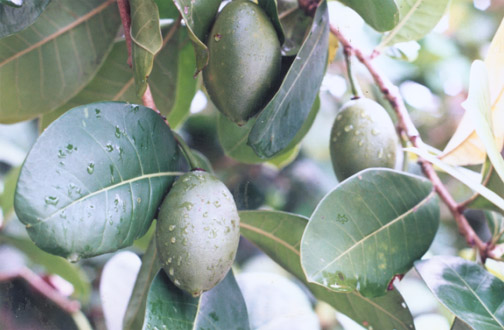Amphitecna latifolia (Mill.) A. Gentry
Bignoniaceae JICARILLO DE LA PLAYA
Tree: Evergreen, understory tree (10-15 m) found exclusively within the narrow strip of extreme coastal vegetation where it is relatively common. The tree maintains large, tubular white flowers and glossy, green pods for much of the year.
Description: Jicarillo is an irregularly shaped tree with a bent and twisting, angular trunk. Small, it rarely exceeds 20 cm in diameter. The bole is clad in tan colored bark that exfoliates in thin, narrow strips – a process that is especially evident in larger individuals. Since this tree occurs in open, well lit areas where the whole bole is exposed to sunlight, branching generally is observed at all levels.  The crown that they form is narrow and moderately dense. Jicarillo has simple, alternate leaves that are large (17 by 7 cm), ovoid, thick and stiff. Waxy, glossy, and dark green, they contrast markedly with the lighter bark of the branches and twigs. Solitary flowers may be found growing amid the foliage or directly from the sides of the bare sections of the larger limbs and even the trunk. They are large (8 cm long by 4.5 cm in diameter), white, and composed of four thick petals fused into a bent and angular corolla tube that flares distally into a trumpet. The green calyx that covers and protects the developing flower during its early development is also fused into one piece, and it splits irregularly when the blossom finally emerges. Five long, black-anthered stamens and a central pistil are found within the perianth. Flowers are nearly present throughout the entire year, only disappearing during the most intense months of the dry season: February, March, and April. Fruits are large (16 cm long by 9 cm in diameter), ovoid, indehiscent green pods with a smooth, glossy texture and an appearance similar to the fruits of the Jicaro (Crescentia alata) tree of drier Guanacaste. Inside the thin, woody skin of the pod is a white fleshy pulp that surrounds several black seeds (3 cm in diameter). Fruits are present in Jicarillo canopies all year round.
The crown that they form is narrow and moderately dense. Jicarillo has simple, alternate leaves that are large (17 by 7 cm), ovoid, thick and stiff. Waxy, glossy, and dark green, they contrast markedly with the lighter bark of the branches and twigs. Solitary flowers may be found growing amid the foliage or directly from the sides of the bare sections of the larger limbs and even the trunk. They are large (8 cm long by 4.5 cm in diameter), white, and composed of four thick petals fused into a bent and angular corolla tube that flares distally into a trumpet. The green calyx that covers and protects the developing flower during its early development is also fused into one piece, and it splits irregularly when the blossom finally emerges. Five long, black-anthered stamens and a central pistil are found within the perianth. Flowers are nearly present throughout the entire year, only disappearing during the most intense months of the dry season: February, March, and April. Fruits are large (16 cm long by 9 cm in diameter), ovoid, indehiscent green pods with a smooth, glossy texture and an appearance similar to the fruits of the Jicaro (Crescentia alata) tree of drier Guanacaste. Inside the thin, woody skin of the pod is a white fleshy pulp that surrounds several black seeds (3 cm in diameter). Fruits are present in Jicarillo canopies all year round.
Similar Species: In its preferred beach-side habitat, there are no other tree species with flowers and fruits like those of Jicarillo – and, fortunately, these structures adorn its crown on a year round basis (fruits) or nearly so (flowers). In drier ecosystems, the Jicaro tree (Crescentia alata) is common, and this species has remarkably similar reproductive structures. Though larger and more spherical, Jicaro fruits are glossy, green and grow from tree limbs and trunks. Hollowed out and dried, they are sometimes used as bowls or jugs with intricate designs etched into their exteriors. This tree has unusual foliage as well, with each leaf resembling a small cross.
Natural History: Pollination of Jicarillo flowers is by insects: predominantly large bumble bees. Possibly, the contents of the large woody pods are eaten by omnivorous mammals, like raccoons and opossums, though this has not been directly observed in Manuel Antonio. Zamora (1989) sites a reference to water dispersal as being effective in the transport of Amphitecna seeds and this could help explain the trees exclusively coastal growth habit in this area. Certainly, the intact pods are buoyant and durable and could be carried considerable distances by ocean currents.
Uses: The white pulp and seeds of the fruit are edible. Jicarillo wood is reportedly hard and rot resistant.
Distribution: In Costa Rica, this species is found along both coasts. It ranges is from south Florida and Mexico to Venezuela and the Antilles (Zamora, 1989).
